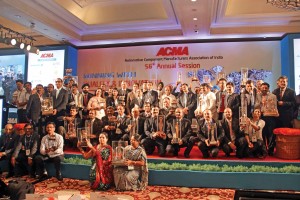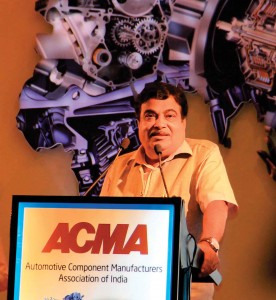Stress was laid on progression to partnering with OEM for product development from being a mere supplier at the 56th Annual Session & National conference hosted by ACMA.
Story & Photos: Bhargav TS
The Indian auto component industry recorded a turnover of Rs.255,600 crore in 2015-16. Exports contributed almost 30 per cent of the Indian auto ancillary industry’s revenue at Rs.70,900 crore. From a long-term perspective, the Automotive Mission Plan (AMP) 2026 has already set ambitious growth aspirations for the ancillary sector with growth in the region of Rs.12,11,500 crore. The AMP has set exports growth ambition to the tune of Rs.462,500 crore, which would roughly amount to 35 to 40 per cent of the overall industry output by 2026. To achieve these goals, the Indian auto ancillary industry, it is clear, will have to align with global trends like electrification and lightweighting. It is clear that the industry players will have to invest in innovation and modern manufacturing practices.
This is what the captains of the Indian ancillary industry underlined at the 56th Annual Session & National Conferencee hosted by Automotive Component Manufacturers Association of India (ACMA) in Delhi recently. The conference reflected upon the changes, challenges and opportunities the industry is foreseeing. With the government’s ‘Make in India’ campaign encourging Indian companies to indulge in local manufacture of high value goods, the auto industry, the captains expressed, have an important role to play. They also drew attention to prospects like ease of doing business, and what key reforms like GST will have to offer. According to ACMA sources, the Indian auto components industry has been focussing on improving quality. There is a need however to be proactive while focusing on holistic qualitative growth. The industry, they said, is investing, working to imbibe culture and develop leadership, which will reflect on commitment and an ability to grow. Sources drew attention to the transformation the global automotive industry is going through with the advent of new technologies and changing regulatory environment. Trends like electrification, connectivity, autonomous driving, advanced material and manufacturing were delved upon at the conference. Focus was also laid on how the automotive industry will transform over the next few years.
The way forward
In order to understand the challenges that lie in front of the Indian auto ancillary industry, and the way forward, ACMA engaged McKinsey & Co. to conduct a study.. The study, ‘Winning with Quality and Innovation’, tabled at the conference, mentioned that the auto component industry, in order to stay competitive, will need to develop in-house design capabilities, harness frugal engineering and create product differentiation through innovation. A move towards product and process innovation, and quality, the study mentioned, will deeply influence growth. It also stressed upon culture being the most critical dimension of quality. Contrary to popular belief, the culture of quality can be created in all organisations regardless of age and size, the study underlined. It highlighted upon four steps to create a quality culture in the organisation. Touching upon the key observations of the study, ACMA sources averred that innovations in the auto components industry have grown quickly and profitably. Innovation historically, they mentioned, have been driven by European suppliers. In the changing global order, the Indian suppliers have found a significant opportunity to innovate, they mentioned. Innovation, said an industry captain on the sidelines of the conference, need not be limited to products and processes, even portfolios and business model make important candidates for innovation. It is they that help to create value, he added.
Quality and technology
Reflecting upon quality and technology, president of ACMA and the joint managing director of Lucas-TVS, Arvind Balaji, expressed that the Indian auto component industry is at a crucial stage where quality and technology will be the key differentiators. To achieve zero defects, the auto components industry will require upgradation of existing facilities and capabilities, he added. He drew attention to the government policy that makes manufacturing more attractive and industry more profitable. India has all the ingredients to be among the leaders of the global automotive industry, mentioned Balaji. “The overall quality levels in the component industry have improved significantly, but there is some more distance to be travelled to meet the global industry levels,” he added. Stressing upon the rapid change the automotive landscape is undergoing globally with integration of digital technologies, and with rising concern for environment and safety, Balaji averred that there is a need for the Indian component industry to move to the next level. With the advent of newer technologies like 3D printing, the digital edge is upon the auto industry, and will lead to unprecedented level of automation. Changes like these will have to be addressed, and will call for significant investment in R&D to create value, expressed an industry figure.
Government support
Emphasising upon government support, union minister for heavy industries and public enterprises, Anant Geete, in his speech mentioned that his government would leave no stone unturned to ensure the auto industry in India grows. He stressed upon the need for the industry to absorb new technology and find frugal ways of working without compromising quality. “New technology is essential to compete at the international level. There is so much more that has to be worked upon. The level of acceptance of new technologies is high in India, it is the utility value that we must focus upon since it is vital to provide global standards of quality to increase exports and make the Indian auto component industry numero uno in the world,” he stated. Geete expressed that the auto-component industry has displayed excellent performance in the last decade. The growth the industry has achieved, has generated tremendous employment opportunities. Stressing upon the Indian auto industry as the primary contributor to manufacturing sector growth, and for ‘Make in India’ programme, Geete averred that his government will help resolve issues troubling the auto industry. and pledge full support. With implementation of GST, industry prospects will improve, he opined.
Union minister for road transport, highways and shipping, Nitin Gadkari, in his speech, assured the ancillary industry of government support. He spoke about the plans to develop internal waterways for transportation to bring down logistic costs. He also spoke about plans for scrapping old vehicles to help make way for new, greener vehicles. “It is essential to bring down logistics costs. To do so, we are trying to connect rivers across India. We are also developing 27 industrial clusters, and are looking at the auto industry to play an important role in it.” In his speech, Rattan Kapur, Vice President of ACMA and CMD of Mark Exhaust Systems, expressed that the industry has to graduate from one that merely ‘builds from print’ to the one that ‘innovates and experiments’. To achieve this, we need to strengthen our relation with the customer, he added. Stressing upon the need to turn co-development partner to OEMs, Kapur stated that there is a need to ‘share risk’ in areas like technology and product development.
Need to scale up
In his keynote address, RC Bhargava, Chairman, Maruti Suzuki India Ltd., emphasised, “The auto component manufacturers need to have a singular focus to scale up their businesses with quality and technology as the bedrock. The industry needs to invest in design and capability, in world class testing and manufacturing facilities, improve profitability of operations in order to become integral with the global supply chain .” Speaking on the theme of ‘Quality and Innovation’, Guenter Butschek, MD & CEO, Tata Motors, said, “The Indian auto industry is going through a very dynamic phase. It is witnessing a dramatic shift in landscape for the auto components industry. Quality and innovation are the cornerstones for success in today’s business environment and at the core of Tata Motors’ new mission and vision, along with a continued focus on R&D investment in design and engineering. We at Tata Motors are looking to streamline our supply chain operations and focus on suppliers with comprehensive capabilities and high performance levels in areas of technical know how, quality, cost, delivery and financial health. We will be rolling out a new supplier capability assessment process with the intention to bring synergies and efficiencies in the whole ecosystem and to create win-win situations for both, Tata Motors and the supplier fraternity.”
Team Spirit
A panel discussion on ‘Winning with Quality and Innovation’ saw eminent speakers from the ancillary industry as well as the government share their views. These included Girish Shankar, Secretary Department of Heavy Industry, Government of India, Rajan Wadhera, President and Chief Executive, Truck & Powertrain Head – Mahindra Research Valley, Mahindra & Mahindra, C V Raman, Executive Director (Engineering), Maruti Suzuki India, Dr. Christian Brenneke, Vice- President – Product Engineering, WABCO Inc., Malo Le Masson, Head – Global Product Planning, Hero MotoCorp, David Keeling, Senior Partner, McKinsey & Company India, and Shivanshu Gupta, Partner, McKinsey & Company. The discussion was moderated by Ashok Taneja, MD and CEO, Shriram Pistons & Rings. Stress was laid on achieving global quality, and an ability to learn best practices to be able to team up with vehicle manufacturers as development partners. Averred CV Raman, that supply chain is critical for smooth functioning. It is they, our partners, that need to be guided in terms of employing best quality practices. To be a global player, they will need to strictly adhere to global quality standards, he added. Wadhera emphasised upon design and engineering as the core parameters to drive the quality culture. Stressing upon the need to engage suppliers from the beginning, he said, at Mahindra we organise supplier capability building programme, which has seen the participation of over 50 suppliers in the last two years. We also conduct Mahindra Supplier Evaluation System, Supply Risk Management and other sessions to help the suppliers to follow best practices, he mentioneds. Malo Le Masson of Hero MotoCorp expressed that in order to meet BS VI emission norms target, vehicle manufacturers need to collaborate with suppliers and focus on R&D. “We have done this earlier, and a good example is the development of Splendor’s start-stop iSmart technology. We are looking at developing technology of global standards at Indian cost. We think it amounts to a good opportunity,” Le Masson stated.
Inputs from Prashant Talreja



























